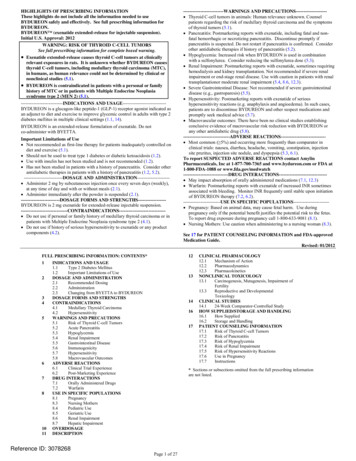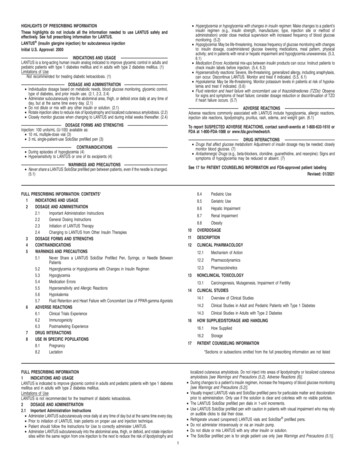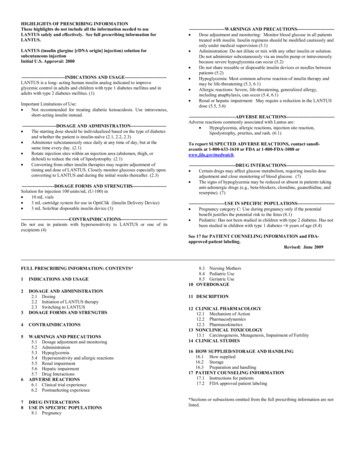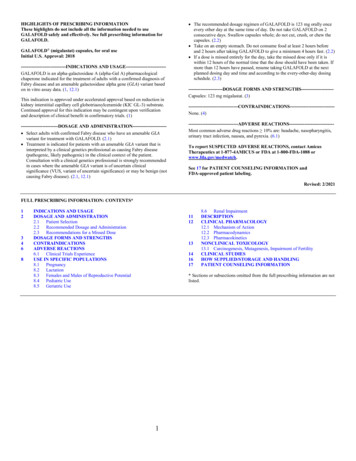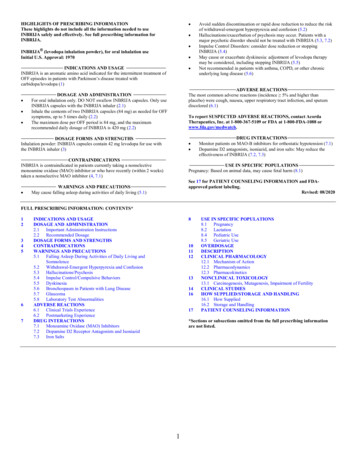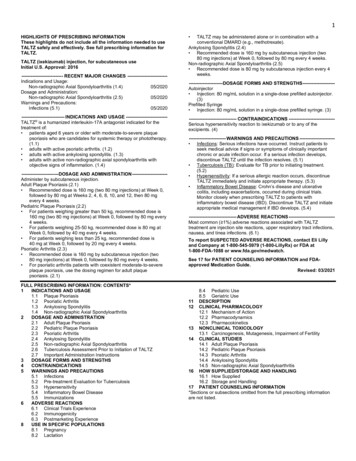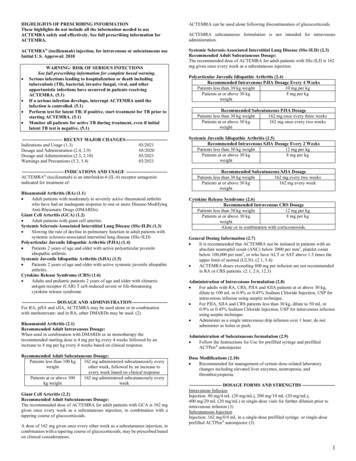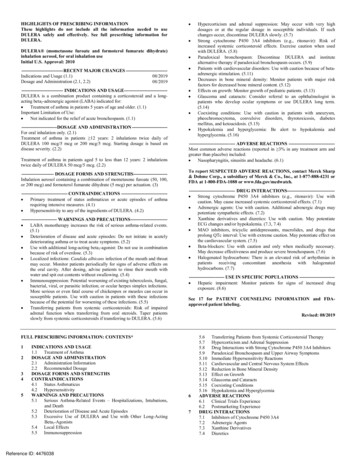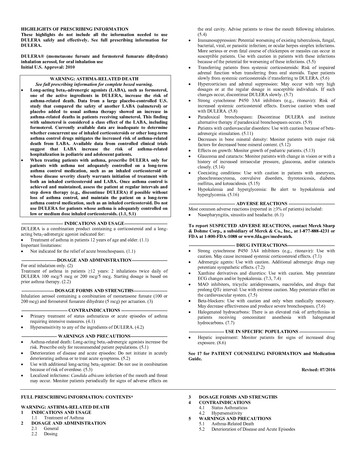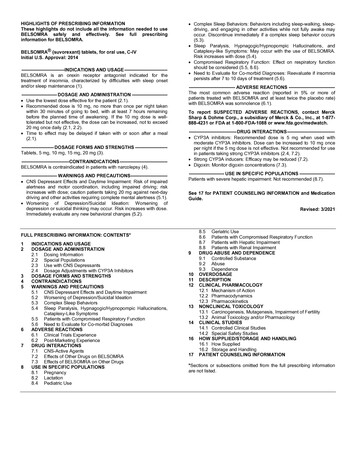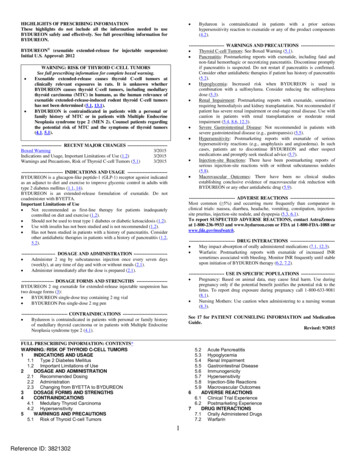
Transcription
HIGHLIGHTS OF PRESCRIBING INFORMATIONThese highlights do not include all the information needed to useBYDUREON safely and effectively. See full prescribing information forBYDUREON.----------------------- WARNINGS AND PRECAUTIONS --------------------- Thyroid C-cell Tumors: See Boxed Warning (5.1). Pancreatitis: Postmarketing reports with exenatide, including fatal andnon-fatal hemorrhagic or necrotizing pancreatitis. Discontinue promptlyif pancreatitis is suspected. Do not restart if pancreatitis is confirmed.Consider other antidiabetic therapies if patient has history of pancreatitis(5.2). Hypoglycemia: Increased risk when BYDUREON is used incombination with a sulfonylurea. Consider reducing the sulfonylureadose (5.3). Renal Impairment: Postmarketing reports with exenatide, sometimesrequiring hemodialysis and kidney transplantation. Not recommended ifpatient has severe renal impairment or end-stage renal disease. Use withcaution in patients with renal transplantation or moderate renalimpairment (5.4, 8.6, 12.3). Severe Gastrointestinal Disease: Not recommended in patients withsevere gastrointestinal disease (e.g., gastroparesis) (5.5). Hypersensitivity: Postmarketing reports with exenatide of serioushypersensitivity reactions (e.g., anaphylaxis and angioedema). In suchcases, patients are to discontinue BYDUREON and other suspectmedications and promptly seek medical advice (5.7). Injection-site Reactions: There have been postmarketing reports ofserious injection-site reactions with or without subcutaneous nodules(5.8). Macrovascular Outcomes: There have been no clinical studiesestablishing conclusive evidence of macrovascular risk reduction withBYDUREON or any other antidiabetic drug (5.9).BYDUREON (exenatide extended-release for injectable suspension)Initial U.S. Approval: 2012 Bydureon is contraindicated in patients with a prior serioushypersensitivity reaction to exenatide or any of the product components(4.2).WARNING: RISK OF THYROID C-CELL TUMORSSee full prescribing information for complete boxed warning.Exenatide extended-release causes thyroid C-cell tumors atclinically relevant exposures in rats. It is unknown whetherBYDUREON causes thyroid C-cell tumors, including medullarythyroid carcinoma (MTC) in humans, as the human relevance ofexenatide extended-release-induced rodent thyroid C-cell tumorshas not been determined (5.1, 13.1).BYDUREON is contraindicated in patients with a personal orfamily history of MTC or in patients with Multiple EndocrineNeoplasia syndrome type 2 (MEN 2). Counsel patients regardingthe potential risk of MTC and the symptoms of thyroid tumors(4.1, 5.1).-------------------------- RECENT MAJOR CHANGES ------------------------- Boxed Warning3/2015Indications and Usage, Important Limitations of Use (1.2)3/2015Warnings and Precautions, Risk of Thyroid C-cell Tumors (5.1)3/2015--------------------------- INDICATIONS AND USAGE ------------------------- BYDUREON is a glucagon-like peptide-1 (GLP-1) receptor agonist indicatedas an adjunct to diet and exercise to improve glycemic control in adults withtype 2 diabetes mellitus (1.1, 14).BYDUREON is an extended-release formulation of exenatide. Do notcoadminister with BYETTA.Important Limitations of Use Not recommended as first-line therapy for patients inadequatelycontrolled on diet and exercise (1.2). Should not be used to treat type 1 diabetes or diabetic ketoacidosis (1.2). Use with insulin has not been studied and is not recommended (1.2). Has not been studied in patients with a history of pancreatitis. Considerother antidiabetic therapies in patients with a history of pancreatitis (1.2,5.2).------------------------------ ADVERSE REACTIONS ---------------------------- Most common ( 5%) and occurring more frequently than comparator inclinical trials: nausea, diarrhea, headache, vomiting, constipation, injectionsite pruritus, injection-site nodule, and dyspepsia (5.3, 6.1).To report SUSPECTED ADVERSE REACTIONS, contact AstraZenecaat 1-800-236-9933 and www.bydureon.com or FDA at 1-800-FDA-1088 --- DRUG INTERACTIONS ---------------------------- May impact absorption of orally administered medications (7.1, 12.3). Warfarin: Postmarketing reports with exenatide of increased INRsometimes associated with bleeding. Monitor INR frequently until stableupon initiation of BYDUREON therapy (6.2, 7.2).---------------------- DOSAGE AND ADMINISTRATION --------------------- Administer 2 mg by subcutaneous injection once every seven days(weekly), at any time of day and with or without meals (2.1). Administer immediately after the dose is prepared (2.1).--------------------- DOSAGE FORMS AND STRENGTHS ------------------- BYDUREON 2 mg exenatide for extended-release injectable suspension hastwo dosage forms (3): BYDUREON single-dose tray containing 2 mg vial BYDUREON Pen single-dose 2 mg pen----------------------- USE IN SPECIFIC POPULATIONS --------------------- Pregnancy: Based on animal data, may cause fetal harm. Use duringpregnancy only if the potential benefit justifies the potential risk to thefetus. To report drug exposure during pregnancy call 1-800-633-9081(8.1). Nursing Mothers: Use caution when administering to a nursing woman(8.3).------------------------------ CONTRAINDICATIONS ---------------------------- Bydureon is contraindicated in patients with personal or family historyof medullary thyroid carcinoma or in patients with Multiple EndocrineNeoplasia syndrome type 2 (4.1).See 17 for PATIENT COUNSELING INFORMATION and MedicationGuide.Revised: 9/2015FULL PRESCRIBING INFORMATION: CONTENTS*WARNING: RISK OF THYROID C-CELL TUMORS1INDICATIONS AND USAGE1.1 Type 2 Diabetes Mellitus1.2 Important Limitations of Use2DOSAGE AND ADMINISTRATION2.1 Recommended Dosing2.2 Administration2.3 Changing from BYETTA to BYDUREON3DOSAGE FORMS AND STRENGTHS4CONTRAINDICATIONS4.1 Medullary Thyroid Carcinoma4.2 Hypersensitivity5WARNINGS AND PRECAUTIONS5.1 Risk of Thyroid C-cell Tumors5.2 Acute Pancreatitis5.3 Hypoglycemia5.4 Renal Impairment5.5 Gastrointestinal Disease5.6 Immunogenicity5.7 Hypersensitivity5.8 Injection-Site Reactions5.9 Macrovascular Outcomes6ADVERSE REACTIONS6.1 Clinical Trial Experience6.2 Postmarketing Experience7DRUG INTERACTIONS7.1 Orally Administered Drugs7.2 Warfarin1Reference ID: 3821302
14CLINICAL STUDIES14.124-Week Comparator-Controlled Study16HOW SUPPLIED/STORAGE AND HANDLING16.1How Supplied16.2Storage and Handling17PATIENT COUNSELING INFORMATION17.1Risk of Thyroid C-cell Tumors17.2Risk of Pancreatitis17.3Risk of Hypoglycemia17.4Risk of Renal Impairment17.5Risk of Hypersensitivity Reactions17.6Risk of Injection-Site Reactions17.7Use in Pregnancy17.8Instructions8USE IN SPECIFIC POPULATIONS8.1 Pregnancy8.3 Nursing Mothers8.4 Pediatric Use8.5 Geriatric Use8.6 Renal Impairment8.7 Hepatic Impairment10OVERDOSAGE11DESCRIPTION12CLINICAL PHARMACOLOGY12.1Mechanism of NCLINICAL TOXICOLOGY13.1Carcinogenesis, Mutagenesis, Impairment of Fertility13.3Reproductive and Developmental Toxicology*Sections or subsections omitted from the full prescribing information are not listed.2Reference ID: 3821302
FULL PRESCRIBING INFORMATIONWARNING: RISK OF THYROID C-CELL TUMORS 1Exenatide extended-release causes an increased incidence in thyroid C-cell tumors atclinically relevant exposures in rats compared to controls. It is unknown whetherBYDUREON causes thyroid C-cell tumors, including medullary thyroid carcinoma(MTC), in humans, as the human relevance of exenatide extended-release-inducedrodent thyroid C-cell tumors has not been determined [see Warnings and Precautions(5.1) and Nonclinical Toxicology (13.1)].BYDUREON is contraindicated in patients with a personal or family history of MTCand in patients with Multiple Endocrine Neoplasia syndrome type 2 (MEN 2). Counselpatients regarding the potential risk for MTC with the use of BYDUREON and informthem of symptoms of thyroid tumors (e.g., mass in the neck, dysphagia, dyspnea,persistent hoarseness). Routine monitoring of serum calcitonin or using thyroidultrasound is of uncertain value for detection of MTC in patients treated withBYDUREON [see Contraindications (4.1) and Warnings and Precautions (5.1)].INDICATIONS AND USAGEBYDUREON is an extended-release formulation of exenatide, administered as an injection onceevery 7 days (weekly).1.1Type 2 Diabetes MellitusBYDUREON is indicated as an adjunct to diet and exercise to improve glycemic control inadults with type 2 diabetes mellitus [see Clinical Studies (14)].1.2Important Limitations of UseBYDUREON is not recommended as first-line therapy for patients who have inadequateglycemic control on diet and exercise because of the uncertain relevance of the rat thyroid C-celltumor findings to humans. Prescribe BYDUREON only to patients for whom the potentialbenefits are considered to outweigh the potential risk [see Warnings and Precautions (5.1)].BYDUREON is not a substitute for insulin. BYDUREON should not be used in patients withtype 1 diabetes or for the treatment of diabetic ketoacidosis, as it would not be effective in thesesettings.The concurrent use of BYDUREON with insulin has not been studied and cannot berecommended.3Reference ID: 3821302
BYDUREON and BYETTA (exenatide) injection both contain the same active ingredient,exenatide, and therefore should not be used together.Based on postmarketing data, exenatide has been associated with acute pancreatitis, includingfatal and non-fatal hemorrhagic or necrotizing pancreatitis. BYDUREON has not been studied inpatients with a history of pancreatitis. It is unknown whether patients with a history ofpancreatitis are at increased risk for pancreatitis while using BYDUREON. Other antidiabetictherapies should be considered in patients with a history of pancreatitis [see Warnings andPrecautions (5.2) and Adverse Reactions (6.2)].2DOSAGE AND ADMINISTRATION2.1Recommended DosingBYDUREON (2 mg per dose) should be administered once every 7 days (weekly). The dose canbe administered at any time of day, with or without meals.Missed DoseIf a dose is missed, it should be administered as soon as noticed, provided the next regularlyscheduled dose is due at least 3 days later. Thereafter, patients can resume their usual dosingschedule of once every 7 days (weekly).If a dose is missed and the next regularly scheduled dose is due 1 or 2 days later, the patientshould not administer the missed dose and instead resume BYDUREON with the next regularlyscheduled dose.Changing Weekly Dosing ScheduleThe day of weekly administration can be changed if necessary as long as the last dose wasadministered 3 or more days before.2.2AdministrationBYDUREON must be injected immediately after the dose is prepared. BYDUREON isadministered as a subcutaneous (SC) injection in the abdomen, thigh, or upper arm region.Advise patients to use a different injection site each week when injecting in the same region.BYDUREON must not be administered intravenously or intramuscularly. BYDUREON isintended for patient self-administration.Prior to initiation of BYDUREON, patients should be trained by their healthcareprofessional. For the BYDUREON Pen, study data demonstrated that training reduced the riskof administration errors such as inadequate mixing or incomplete dosing. Patients using theBYDUREON Pen should be trained on proper mixing and injection technique to ensure theproduct is adequately mixed and a full dose is delivered. Refer to the accompanying4Reference ID: 3821302
Instructions for Use for complete administration instructions with illustrations. Theinstructions can also be found at www.bydureon.com.2.3Changing from BYETTA to BYDUREONPrior treatment with BYETTA is not required when initiating BYDUREON therapy. If thedecision is made to start BYDUREON in an appropriate patient already taking BYETTA,BYETTA should be discontinued. Patients changing from BYETTA to BYDUREON mayexperience transient (approximately 2 weeks) elevations in blood glucose concentrations.3DOSAGE FORMS AND STRENGTHSBYDUREON exenatide extended-release for injectable suspension is available as: BYDUREON single-dose tray which contains one vial of 2 mg exenatide, one vialconnector, one prefilled diluent syringe, and two needles (one provided as a spare).BYDUREON Pen. Each single-dose pen contains 2 mg of exenatide and diluent, andincludes one needle. Each carton contains one spare needle.Do not substitute needles or any other components provided with BYDUREON. See HowSupplied/Storage and Handling (16.1) for additional information.4CONTRAINDICATIONS4.1Medullary Thyroid CarcinomaBYDUREON is contraindicated in patients with a personal or family history of medullarythyroid carcinoma (MTC) or in patients with Multiple Endocrine Neoplasia syndrome type 2(MEN 2).4.2HypersensitivityBYDUREON is contraindicated in patients with a prior serious hypersensitivity reaction toexenatide or to any of the product components.5WARNINGS AND PRECAUTIONS5.1Risk of Thyroid C-cell TumorsIn both genders of rats, exenatide extended-release caused a dose-related and treatment-duration–dependent increase in the incidence of thyroid C-cell tumors (adenomas and/or carcinomas) atclinically relevant exposures compared to controls [see Nonclinical Toxicology (13.1)]. Astatistically significant increase in malignant thyroid C-cell carcinomas was observed in femalerats receiving exenatide extended-release at 25-times clinical exposure compared to controls andhigher incidences were noted in males above controls in all treated groups at 2-times clinical5Reference ID: 3821302
exposure. The potential of exenatide extended-release to induce C-cell tumors in mice has notbeen evaluated. Other GLP-1 receptor agonists have also induced thyroid C-cell adenomas andcarcinomas in male and female mice and rats at clinically relevant exposures. It is unknownwhether BYDUREON will cause thyroid C-cell tumors, including medullary thyroid carcinoma(MTC), in humans as the human relevance of exenatide extended-release–induced rodent thyroidC-cell tumors has not been determined.Cases of MTC in patients treated with liraglutide, another GLP-1 receptor agonist, have beenreported in the postmarketing period; the data in these reports are insufficient to establish orexclude a causal relationship between MTC and GLP-1 receptor agonist use in humans.BYDUREON is contraindicated in patients with a personal or family history of MTC or inpatients with MEN 2. Counsel patients regarding the potential risk of MTC with the use ofBYDUREON and inform them of symptoms of thyroid tumors (e.g., a mass in the neck,dsyphagia, dyspnea, persistent hoarseness).Routine monitoring of serum calcitonin or using thyroid ultrasound is of uncertain value for earlydetection of MTC in patients treated with BYDUREON. Such monitoring may increase the riskof unnecessary procedures, due to the low specificity of serum calcitonin testing for MTC and ahigh background incidence of thyroid disease. Significantly elevated serum calcitonin mayindicate MTC and patients with MTC usually have values 50 ng/L. If serum calcitonin ismeasured and found to be elevated, the patient should be further evaluated. Patients with thyroidnodules noted on physical examination or neck imaging should also be further evaluated.5.2Acute PancreatitisBased on postmarketing data, exenatide has been associated with acute pancreatitis,including fatal and non-fatal hemorrhagic or necrotizing pancreatitis. After initiation ofBYDUREON, observe patients carefully for signs and symptoms of pancreatitis (includingpersistent severe abdominal pain, sometimes radiating to the back, which may or may notbe accompanied by vomiting). If pancreatitis is suspected, BYDUREON should promptlybe discontinued and appropriate management should be initiated. If pancreatitis isconfirmed, BYDUREON should not be restarted. Consider antidiabetic therapies otherthan BYDUREON in patients with a history of pancreatitis.5.3HypoglycemiaThe risk of hypoglycemia is increased when exenatide is used in combination with asulfonylurea. Therefore, patients receiving BYDUREON and a sulfonylurea may require a lowerdose of the sulfonylurea to minimize the risk of hypoglycemia. It is also possible that the use ofBYDUREON with other glucose-independent insulin secretagogues (e.g., meglitinides) couldincrease the risk of hypoglycemia.For additional information on glucose-dependent effects see Clinical Pharmacology (12.1).6Reference ID: 3821302
5.4Renal ImpairmentBYDUREON should not be used in patients with severe renal impairment (creatinine clearance 30 mL/min) or end-stage renal disease and should be used with caution in patients with renaltransplantation [see Use in Specific Populations (8.6)]. In patients with end-stage renal diseasereceiving dialysis, single doses of BYETTA 5 mcg were not well tolerated due to gastrointestinalside effects. Because BYDUREON may induce nausea and vomiting with transienthypovolemia, treatment may worsen renal function. Use BYDUREON with caution in patientswith moderate renal impairment (creatinine clearance 30-50 mL/min) [see Use in SpecificPopulations (8.6) and Clinical Pharmacology (12.3)]. BYDUREON has not been studied inpatients with end-stage renal disease or severe renal impairment.There have been postmarketing reports of altered renal function with exenatide, includingincreased serum creatinine, renal impairment, worsened chronic renal failure and acute renalfailure, sometimes requiring hemodialysis or kidney transplantation. Some of these eventsoccurred in patients receiving one or more pharmacologic agents known to affect renal functionor hydration status such as angiotensin converting enzyme inhibitors, nonsteroidal antiinflammatory drugs, or diuretics. Some events occurred in patients who had been experiencingnausea, vomiting, or diarrhea, with or without dehydration. Reversibility of altered renal functionhas been observed in many cases with supportive treatment and discontinuation of potentiallycausative agents, including exenatide. Exenatide has not been found to be directly nephrotoxic inpreclinical or clinical studies.5.5Gastrointestinal DiseaseExenatide has not been studied in patients with severe gastrointestinal disease, includinggastroparesis. Because exenatide is commonly associated with gastrointestinal adverse reactions,including nausea, vomiting, and diarrhea, the use of BYDUREON is not recommended inpatients with severe gastrointestinal disease.5.6ImmunogenicityPatients may develop antibodies to exenatide following treatment with BYDUREON. Anti exenatide antibodies were measured in all BYDUREON-treated patients in the five comparatorcontrolled 24- to 30-week studies of BYDUREON. In 6% of BYDUREON-treated patients,antibody formation was associated with an attenuated glycemic response. If there is worseningglycemic control or failure to achieve targeted glycemic control, alternative antidiabetic therapyshould be considered [see Adverse Reactions (6.1)].5.7HypersensitivityThere have been postmarketing reports of serious hypersensitivity reactions (e.g., anaphylaxisand angioedema) in patients treated with exenatide. If a hypersensitivity reaction occurs, the7Reference ID: 3821302
patient should discontinue BYDUREON and other suspect medications and promptly seekmedical advice [see Adverse Reactions (6.2)].5.8Injection-Site ReactionsThere have been postmarketing reports of serious injection-site reactions (e.g., abscess, cellulitis,and necrosis), with or without subcutaneous nodules, with the use of BYDUREON. Isolatedcases required surgical intervention [see Adverse Reactions (6.2)].5.9Macrovascular OutcomesThere have been no clinical studies establishing conclusive evidence of macrovascular riskreduction with BYDUREON or any other antidiabetic drug.6ADVERSE REACTIONSThe following serious adverse reactions are described below or elsewhere in the prescribinginformation:
BYDUREON exenatide extended-release for injectable suspension is available as: BYDUREON single-dose tray which contains one vial of 2 mg exenatide, one vial connector, one prefilled diluent syringe, and two needles (one provided as a spare). BYDUREON Pen. Each singledose pen contains
